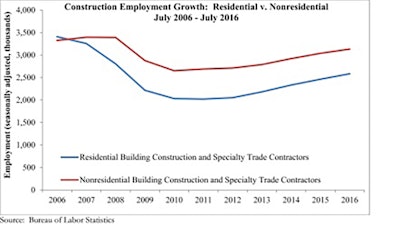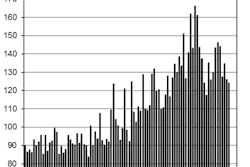
The U.S. construction industry has rebounded strongly, adding 14,000 net new jobs in July according to an Associated Builders and Contractors (ABC) analysis of Bureau of Labor Statistics data. This gain comes after the construction sector lost a combined 27,000 jobs from April to June. The construction industry’s unemployment rate inched lower in July, shedding a tenth of a percentage point to reach 4.5%, the industry’s lowest unemployment rate since October 2006.
The nonresidential sector accounted for a majority of July’s gains, adding 11,500 net new jobs. The residential sector remained stagnant for the month, adding only 700 net new positions. Heavy and civil engineering employment, which lost 8,800 jobs from January to June, experienced a modest rebound in July by adding 1,900 net new jobs.
“After several months of disappointing construction spending and employment data, today’s release was most welcome,” said ABC Chief Economist Anirban Basu. “If there is a slowdown in construction, it appears to be in residential as opposed to nonresidential activity. Today’s release provides evidence that the nonresidential construction recovery has not yet stalled.
“While hiring in July was strong both in the broader economy and in key nonresidential construction segments, ongoing job creation exacerbates the issue of rampant skilled labor shortage,” said Basu. “The construction unemployment rate is now down to 4.5 percent. The implication is that wage pressures continue to build. Therefore, contractors will likely need to more aggressively pass along cost increases to purchasers of construction services in order to simply maintain their current level of profitability.
“For now, America’s economic recovery remains in place,” said Basu. “Not only does the economy continue to add jobs, but labor force participation has begun to rise again. This should position America’s ongoing consumer-led expansion to continue, creating demand for commercial construction and other forms of construction in the process.”
The economy-wide unemployment rate remained unchanged at 4.9%. The nation’s labor force expanded by 407,000 persons for the month. This represents the largest growth for the month of July since the labor force expanded by 587,000 persons in July 1996





![[VIDEO] Could Q2 Spending Slide Signal Turning Point for Construction?](https://img.forconstructionpros.com/files/base/acbm/fcp/image/2016/08/default.57b228e2a27c9.png?auto=format%2Ccompress&fit=crop&h=167&q=70&w=250)












